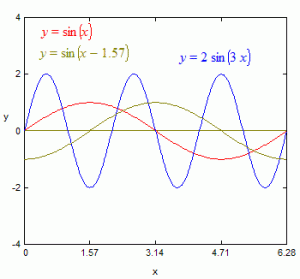Review of the Types of Graphs
Learning Objectives
This section reviews the different types of graphs in general. We assume that most of you are probably familiar with this information so feel free to skip it. However, in case you need a refresher, the material below is provided from
E. Hoib, The Algebra Help e-Book. Section 5.2 Reference – Graphs of eight basic types of functions. Copyright 2018. Used with permission.
Feel free to follow any of the links for more information on each type of graph.
The purpose of this reference section is to show you graphs of various types of functions in order that you can become familiar with the types. You will discover that each type has its own distinctive graph. By showing several graphs on one plot you will be able to see their common features. Examples of the following types of functions are shown in this gallery:
In each case the argument (input) of the function is called x and the value (output) of the function is called y.
Linear functions
These are functions of the form:
y = m x + b,
where m and b are constants. A typical use for linear functions is converting from one quantity or set of units to another. Graphs of these functions are straight lines. m is the slope and b is the y intercept. If m is positive then the line rises to the right and if m is negative then the line falls to the right. Linear functions are described in detail here.

Quadratic Functions
These are functions of the form:
y = a x 2 + b x + c,
where a, b and c are constants. Their graphs are called parabolas. This is the next simplest type of function after the linear function. Falling objects move along parabolic paths. If a is a positive number then the parabola opens upward and if a is a negative number then the parabola opens downward. Quadratic functions are described in detail here.
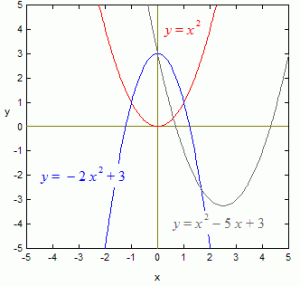
Power Functions
These are functions of the form:
y = a x b,
where a and b are constants. They get their name from the fact that the variable x is raised to some power. Many physical laws (e.g. the gravitational force as a function of distance between two objects, or the bending of a beam as a function of the load on it) are in the form of power functions. We will assume that a = 1 and look at several cases for b below. The power function is discussed in detail here.
The power b is a positive integer.
See the graph below. When x = 0 these functions are all zero. When x is big and positive they are all big and positive. When x is big and negative then the ones with even powers are big and positive while the ones with odd powers are big and negative.
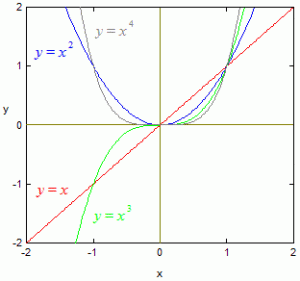
The power b is a negative integer.
See the graph to the right. When x = 0 these functions suffer a division by zero and therefore are all infinite. When x is big and positive they are small and positive. When x is big and negative then the ones with even powers are small and positive while the ones with odd powers are small and negative.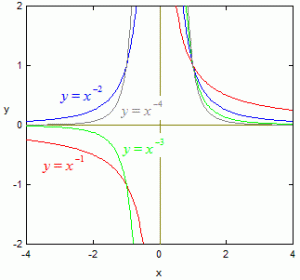
The power b is a fraction between 0 and 1.
See the graph below. When x = 0 these functions are all zero. The curves are vertical at the origin and as x increases they increase but curve toward the x axis.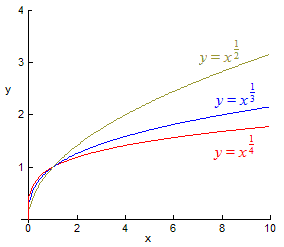
Polynomial Functions
These are functions of the form:
y = an · x n + an −1 · x n −1 + … + a2 · x 2 + a1 · x + a0,
where an, an −1, … , a2, a1, a0 are constants. Only whole number powers of x are allowed. The highest power of x that occurs is called the degree of the polynomial. The graph shows examples of degree 4 and degree 5 polynomials. The degree gives the maximum number of “ups and downs” that the polynomial can have and also the maximum number of crossings of the x axis that it can have.
Polynomials are useful for generating smooth curves in computer graphics applications and for approximating other types of functions. Polynomials are described in detail here.
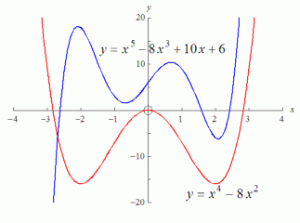
Exponential Functions
These are functions of the form:
y = a b x,
where x is in an exponent (not in the base as was the case for power functions) and a and b are constants. (Note that only b is raised to the power x; not a.) If the base b is greater than 1 then the result is exponential growth. Many physical quantities grow exponentially (e.g. animal populations and cash in an interest-bearing account).
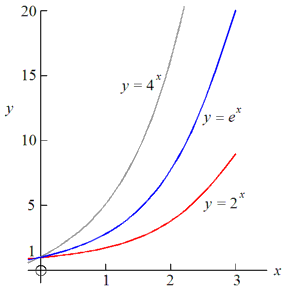
If the base b is smaller than 1 then the result is exponential decay. Many quantities decay exponentially (e.g. the sunlight reaching a given depth of the ocean and the speed of an object slowing down due to friction).
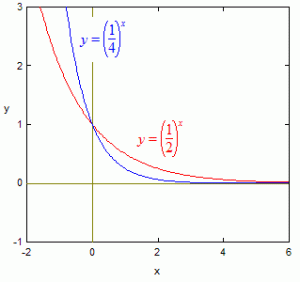
Exponential functions are described in detail here.
Logarithmic Functions
There are many equivalent ways to define logarithmic functions. We will define them to be of the form:
y = a ln (x) + b,
or
y = a log (x) + b,
where x is in the natural logarithm and a and b are constants. They are only defined for positive x. For small x they are negative and for large x they are positive but stay small. Logarithmic functions accurately describe the response of the human ear to sounds of varying loudness and the response of the human eye to light of varying brightness. Logarithmic functions are described in detail here.
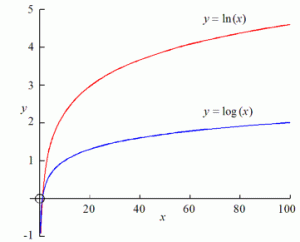
Sinusoidal Functions
These are functions of the form:
y = a sin (b x + c),
or
y = a cos (b x + c),
where a, b and c are constants. Sinusoidal functions are useful for describing anything that has a wave shape with respect to position or time. Examples are waves on the water, the height of the tide during the course of the day and alternating current in electricity. Parameter a (called the amplitude) affects the height of the wave, b (the angular velocity) affects the width of the wave and c (the phase angle) shifts the wave left or right. Sinusoidal functions are described in detail here.
